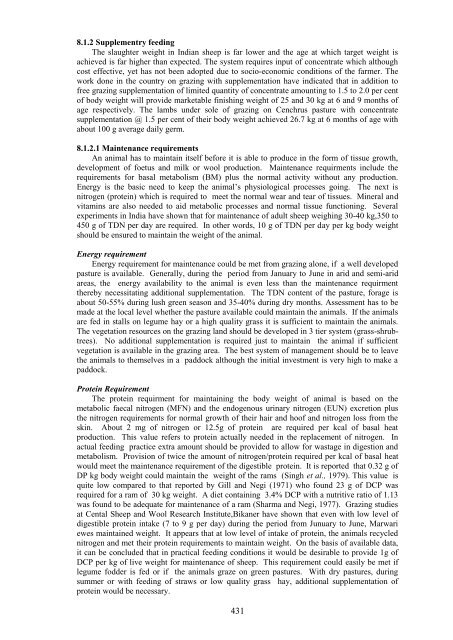Create successful ePaper yourself
Turn your PDF publications into a flip-book with our unique Google optimized e-Paper software.
8.1.2 Supplementry feeding<br />
The slaughter weight in Indian sheep is far lower and the age at which target weight is<br />
achieved is far higher than expected. The system requires input of concentrate which although<br />
cost effective, yet has not been adopted due to socio-economic conditions of the farmer. The<br />
work done in the country on grazing with supplementation have indicated that in addition to<br />
free grazing supplementation of limited quantity of concentrate amounting to 1.5 to 2.0 per cent<br />
of body weight will provide marketable finishing weight of 25 and 30 kg at 6 and 9 months of<br />
age respectively. The lambs under sole of grazing on Cenchrus pasture with concentrate<br />
supplementation @ 1.5 per cent of their body weight achieved 26.7 kg at 6 months of age with<br />
about 100 g average daily germ.<br />
8.1.2.1 Maintenance requirements<br />
An animal has to maintain itself before it is able to produce in the form of tissue growth,<br />
development of foetus and milk or wool production. Maintenance requirments include the<br />
requirements for basal metabolism (BM) plus the normal activity without any production.<br />
Energy is the basic need to keep the animal‘s physiological processes going. The next is<br />
nitrogen (protein) which is required to meet the normal wear and tear of tissues. Mineral and<br />
vitamins are also needed to aid metabolic processes and normal tissue functioning. Several<br />
experiments in India have shown that for maintenance of adult sheep weighing 30-40 kg,350 to<br />
450 g of TDN per day are required. In other words, 10 g of TDN per day per kg body weight<br />
should be ensured to maintain the weight of the animal.<br />
Energy requirement<br />
Energy requirement for maintenance could be met from grazing alone, if a well developed<br />
pasture is available. Generally, during the period from January to June in arid and semi-arid<br />
areas, the energy availability to the animal is even less than the maintenance requirment<br />
thereby necessitating additional supplementation. The TDN content of the pasture, forage is<br />
about 50-55% during lush green season and 35-40% during dry months. Assessment has to be<br />
made at the local level whether the pasture available could maintain the animals. If the animals<br />
are fed in stalls on legume hay or a high quality grass it is sufficient to maintain the animals.<br />
The vegetation resources on the grazing land should be developed in 3 tier system (grass-shrubtrees).<br />
No additional supplementation is required just to maintain the animal if sufficient<br />
vegetation is available in the grazing area. The best system of management should be to leave<br />
the animals to themselves in a paddock although the initial investment is very high to make a<br />
paddock.<br />
Protein Requirement<br />
The protein requirment for maintaining the body weight of animal is based on the<br />
metabolic faecal nitrogen (MFN) and the endogenous urinary nitrogen (EUN) excretion plus<br />
the nitrogen requirements for normal growth of their hair and hoof and nitrogen loss from the<br />
skin. About 2 mg of nitrogen or 12.5g of protein are required per kcal of basal heat<br />
production. This value refers to protein actually needed in the replacement of nitrogen. In<br />
actual feeding practice extra amount should be provided to allow for wastage in digestion and<br />
metabolism. Provision of twice the amount of nitrogen/protein required per kcal of basal heat<br />
would meet the maintenance requirement of the digestible protein. It is reported that 0.32 g of<br />
DP kg body weight could maintain the weight of the rams (Singh et al., 1979). This value is<br />
quite low compared to that reported by Gill and Negi (1971) who found 23 g of DCP was<br />
required for a ram of 30 kg weight. A diet containing 3.4% DCP with a nutritive ratio of 1.13<br />
was found to be adequate for maintenance of a ram (Sharma and Negi, 1977). Grazing studies<br />
at Cental <strong>Sheep</strong> and Wool Research Institute,Bikaner have shown that even with low level of<br />
digestible protein intake (7 to 9 g per day) during the period from Junuary to June, Marwari<br />
ewes maintained weight. It appears that at low level of intake of protein, the animals recycled<br />
nitrogen and met their protein requirements to maintain weight. On the basis of available data,<br />
it can be concluded that in practical feeding conditions it would be desirable to provide 1g of<br />
DCP per kg of live weight for maintenance of sheep. This requirement could easily be met if<br />
legume fodder is fed or if the animals graze on green pastures. With dry pastures, during<br />
summer or with feeding of straws or low quality grass hay, additional supplementation of<br />
protein would be necessary.<br />
431




